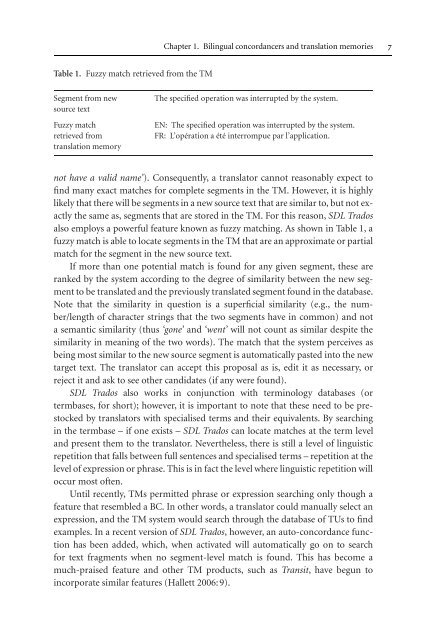Topics in Language Resources for Translation ... - ymerleksi - home
Topics in Language Resources for Translation ... - ymerleksi - home
Topics in Language Resources for Translation ... - ymerleksi - home
- No tags were found...
You also want an ePaper? Increase the reach of your titles
YUMPU automatically turns print PDFs into web optimized ePapers that Google loves.
Chapter 1. Bil<strong>in</strong>gual concordancers and translation memories 7Table 1. Fuzzy match retrieved from the TMSegment from newsource textFuzzy matchretrieved fromtranslation memoryThe specified operation was <strong>in</strong>terrupted by the system.EN: The specified operation was <strong>in</strong>terrupted by the system.FR: L’opération a été <strong>in</strong>terrompue par l’application.not have a valid name’). Consequently, a translator cannot reasonably expect tof<strong>in</strong>d many exact matches <strong>for</strong> complete segments <strong>in</strong> the TM. However, it is highlylikely that there will be segments <strong>in</strong> a new source text that are similar to, but not exactlythe same as, segments that are stored <strong>in</strong> the TM. For this reason, SDL Tradosalso employs a powerful feature known as fuzzy match<strong>in</strong>g. As shown <strong>in</strong> Table 1, afuzzy match is able to locate segments <strong>in</strong> the TM that are an approximate or partialmatch <strong>for</strong> the segment <strong>in</strong> the new source text.If more than one potential match is found <strong>for</strong> any given segment, these areranked by the system accord<strong>in</strong>g to the degree of similarity between the new segmentto be translated and the previously translated segment found <strong>in</strong> the database.Note that the similarity <strong>in</strong> question is a superficial similarity (e.g., the number/lengthof character str<strong>in</strong>gs that the two segments have <strong>in</strong> common) and nota semantic similarity (thus ‘gone’ and ‘went’ will not count as similar despite thesimilarity <strong>in</strong> mean<strong>in</strong>g of the two words). The match that the system perceives asbe<strong>in</strong>g most similar to the new source segment is automatically pasted <strong>in</strong>to the newtarget text. The translator can accept this proposal as is, edit it as necessary, orreject it and ask to see other candidates (if any were found).SDL Trados also works <strong>in</strong> conjunction with term<strong>in</strong>ology databases (ortermbases, <strong>for</strong> short); however, it is important to note that these need to be prestockedby translators with specialised terms and their equivalents. By search<strong>in</strong>g<strong>in</strong> the termbase – if one exists – SDL Trados can locate matches at the term leveland present them to the translator. Nevertheless, there is still a level of l<strong>in</strong>guisticrepetition that falls between full sentences and specialised terms – repetition at thelevel of expression or phrase. This is <strong>in</strong> fact the level where l<strong>in</strong>guistic repetition willoccur most often.Until recently, TMs permitted phrase or expression search<strong>in</strong>g only though afeature that resembled a BC. In other words, a translator could manually select anexpression, and the TM system would search through the database of TUs to f<strong>in</strong>dexamples. In a recent version of SDL Trados, however, an auto-concordance functionhas been added, which, when activated will automatically go on to search<strong>for</strong> text fragments when no segment-level match is found. This has become amuch-praised feature and other TM products, such as Transit,havebegunto<strong>in</strong>corporate similar features (Hallett 2006:9).
















